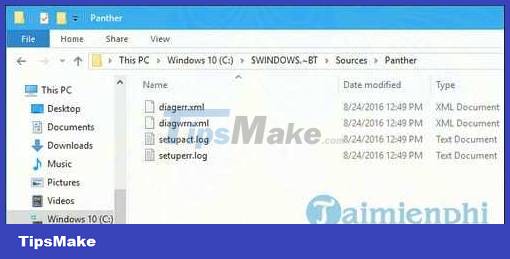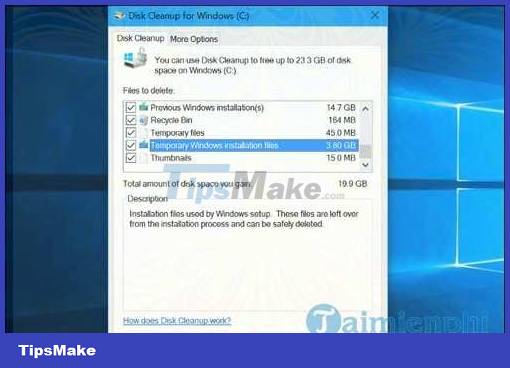What is the $WINDOWS.~BT directory? Is it possible to delete this folder?
$WINDOWS.~BT and $WINDOWS.~WS are folders related to the Windows 10 upgrade process. These folders can be present on Windows 7, 8 and 10 computers and take up a lot of disk space.

What is the $WINDOWS.~BT directory?
By default these are hidden folders, so you will have to take extra steps to show these hidden folders on Windows Explorer (or File Explorer) to be able to see the folders.
See more steps to show hidden files and folders on Windows 7/8/10 here.
On Windows 7 and Windows 8
During the free upgrade to Windows 10, Windows 7 ISO and 8 automatically download the Windows 10 installation files and store them in the $WINDOWS.~BT folder. When you upgrade to Windows 10 the system will use these files to quickly install the new operating system version.
However, the free upgrade version has expired, so you cannot use these files to upgrade to Windows 10.
Although Microsoft will remove these files, in fact these files are still 'present' on Windows 7 ISO and Windows 8 computers.
On Windows 10
On Windows 10, the $WINDOWS.~BT folder contains the installation files of previous versions. These files are used in case to downgrade to a previous version of Windows or a previous build of Windows 10.
The $WINDOWS.~BT folder is similar to the Windows.old folder, containing the installation files of the previous Windows version. In fact, you will see both Windows.old and $WINDOWS.~BT folders after upgrading to Windows 10.
In addition, the $WINDOWS.~BT directory also contains the log file. For example, if you download and run the Media Creation Tool, it will create a directory $WINDOWS.~BT containing log files. In addition, this Media Creation Tool also creates a folder containing Windows installation files.
On the Anniversary Update update, Windows will automatically delete these files after 10 days to free up space, or after 30 days if your computer has not upgraded to the Anniversary Update update.

Is it possible to delete $WINDOWS.~BT and how to delete it?
Warning: If you delete the $WINDOWS.~BT folder on Windows 10, you cannot downgrade to a previous build of Windows 10 or previously installed versions of Windows.
The option to downgrade the computer to the previous version in Settings => Update & Security => Recovery will also disappear. However, Windows 10 will also automatically delete these files after 10 days.
If you want you can also delete these files, but not in the usual way. Instead you will have to use the Disk Cleanup tool built into Windows versions.
To do this, access the built-in Disk Cleanup tool, then click Clean Up System File . Check the boxes below to delete files:
- Previous Windows installation(s) : delete the $WINDOWS.~BT folder and the Windows.old folder on Windows 10.
- Temporary Windows installation files : delete the $WINDOWS.~BT folder on Windows 7 and 8 and the $WINDOWS.~WS folder on Windows 10.
Click OK to delete these files.

After performing the above steps and the $WINDOWS.~BT file is still present, maybe the directory contains only a few log files. Now you can delete the folder right on File Explorer. Just right-click the folder and select Delete .
On Windows there are a lot of hidden files, in addition to $WINDOWS.~BT there is also a Windows.old file, this is a file that stores old operating system data when you install a new operating system for your computer, so there is can delete Windows.old as $WINDOWS.~BT? you can also delete Windows.old to free up space, however, if you keep it, it will be easier when you want to use that operating system again.
Deleting files on Windows is as easy as removing apps on Android, when you no longer want to use an application, you should delete that application to increase memory card usage and install many other Apps. Uninstalling applications on Android has been introduced by us in detail, if you are interested, please refer to it.
https://thuthuat.taimienphi.vn/thu-muc-windows-bt-la-gi-co-the-xoa-thu-muc-nay-duoc-khong-24460n.aspx
The folder $WINDOWS.~BT appears only when you show the folder in Windows, just like $WINDOWS.~BT, the two folders $GetCurrent and $SysReset also appear due to many activities on the computer, see the introduction of the $GetCurrent and $SysReset folders for more details.
You should read it
- What does the red 'X' on Windows folders mean?
- How to change the download folder Windows Update in Windows 10
- Instructions to delete Windows.old folder on Windows 7/8 / 8.1?
- How to activate the Sharing folder tab on Windows 10
- How to Zip Folder on Windows
- Steps to turn off Folder Options on Windows 10
- Tips to change the default name of the newly created folder on Windows 10
- How to Set Password for Folder and File in Windows
May be interested
- What is the root directory?
 the root directory, also called the root directory or sometimes is simply a root, of any partition is the highest directory in the hierarchy.
the root directory, also called the root directory or sometimes is simply a root, of any partition is the highest directory in the hierarchy. - How to safely delete Windows10Upgrade folder in Windows 10
 many pc users wonder about the windows10 upgrade folder located in the windows 10. installation directory. what is it and is it safe to delete? the answer will be in the following article.
many pc users wonder about the windows10 upgrade folder located in the windows 10. installation directory. what is it and is it safe to delete? the answer will be in the following article. - How to delete the Ansel folder on the computer
 how to delete the ansel folder. the ansel folder only appears on computers with discrete nvidia cards with the main purpose of saving high-quality screenshots and hdr images while playing games. what's special is when you delete this folder and it can reappear
how to delete the ansel folder. the ansel folder only appears on computers with discrete nvidia cards with the main purpose of saving high-quality screenshots and hdr images while playing games. what's special is when you delete this folder and it can reappear - How to Change Default Folder in Windows Terminal
 by default, windows terminal will use your current user directory as the default directory when you open it. however, you can completely change this folder to any other folder on your windows pc.
by default, windows terminal will use your current user directory as the default directory when you open it. however, you can completely change this folder to any other folder on your windows pc. - How to delete the Windows.old folder in Windows 11
 windows will automatically delete windows.old 30 days after its creation. but if you need that storage right now, you can try any of these methods to remove the folder from your pc.
windows will automatically delete windows.old 30 days after its creation. but if you need that storage right now, you can try any of these methods to remove the folder from your pc. - 4 ways to delete Windows.old folder on Windows 10 computer
 instructions on how to delete the windows.old folder on windows 10 with ccleaner, disk cleanup, command prompt, easy and fast storage feature. click view now!
instructions on how to delete the windows.old folder on windows 10 with ccleaner, disk cleanup, command prompt, easy and fast storage feature. click view now! - Instructions for fixing errors: 'You Have Been Denied Permission To Access This Folder' on Windows 10
 lỗi 'bạn đã được phép phép phép phép truy cập này folder. to gain access to this folder you will need to use the security tab 'appear when you try to access a protected system folder on windows 10 or previous windows operating systems. for example, if you try to access the windowsapps folder, then you will receive an error message on the screen.
lỗi 'bạn đã được phép phép phép phép truy cập này folder. to gain access to this folder you will need to use the security tab 'appear when you try to access a protected system folder on windows 10 or previous windows operating systems. for example, if you try to access the windowsapps folder, then you will receive an error message on the screen. - 6 ways to rename files and folders in Windows 10
 renaming a file or folder is a common task that is probably familiar to any windows user. however, few people know that there are 6 different ways to rename a file or folder on windows 10, specifically as follows:
renaming a file or folder is a common task that is probably familiar to any windows user. however, few people know that there are 6 different ways to rename a file or folder on windows 10, specifically as follows: - How to use Folder Guard to set a folder password
 folder guard is a directory password software, which helps users secure their computer folders, but the folders are not hidden.
folder guard is a directory password software, which helps users secure their computer folders, but the folders are not hidden. - What is the $ GetCurrent and $ SysReset directories? Can these two folders be deleted?
 windows 10 automatically creates $ getcurrent and $ sysreset folders on c: drive in specific situations. so what are they and can they be deleted to free up storage space?
windows 10 automatically creates $ getcurrent and $ sysreset folders on c: drive in specific situations. so what are they and can they be deleted to free up storage space?










 What's so scary about the Y2K38 incident? Is it like Y2K in 2000?
What's so scary about the Y2K38 incident? Is it like Y2K in 2000? What's the difference between Intel Core and Intel Core X CPUs?
What's the difference between Intel Core and Intel Core X CPUs? What is Apple's Lost Mode?
What is Apple's Lost Mode? What is TPU (Tensor Processing Unit) and how is it used?
What is TPU (Tensor Processing Unit) and how is it used? What are PST files? How to open PST . files
What are PST files? How to open PST . files Web4: SQL injection - Exploitation steps
Web4: SQL injection - Exploitation steps